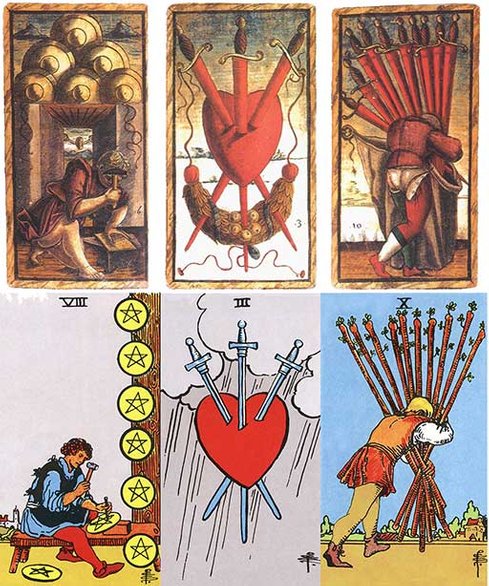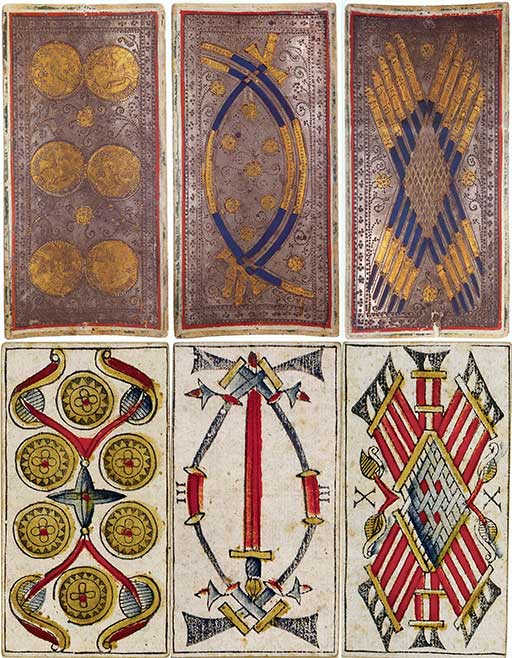THE TAROT WHEEL
INTRODUCTION TO THE TAROT WHEEL
Almost everyone has heard of the Tarot. In the past and/or elsewhere, decks of the same type, consisting of four different suits and a separate trump suit, have been called by other names such as Trionfi, Taraut, Tarock, Tarocco, Tarocchino and Minchate. Most Tarot decks have 78 cards. But this can be less, like the Renaissance Trionfi decks (70 cards) and the Bolognese Tarocchini decks (62 cards), or more, like the 15th century Milanese Visconti di Modrone decks (probably 80 cards) and the Florentine Minchiate decks (97 cards). On these pages, when I talk about Tarot, I mean a deck of 78 cards, of which 22 are trumps and 56 are suits. All other Tarot-related decks will be referred to by their proper names.
Classic Tarot decks, such as the Tarot of Marseilles, have standard illustrations. In modern decks, however, any theme is possible. We have Nature Tarots, Wicca Tarots, Erotic Tarots, Animal Tarots, Children's Tarots, Celtic Tarots, Satan's Tarots, Egyptian Tarots, you name it, think of a theme and you will almost certainly find a deck that corresponds to what you are looking for. The illustrations are adapted to the theme, and even the names of some of the cards have been changed. All of these decks can be used for divination. Ask the right question, lay the cards in a spread that matches that question, and the cards will help you find an answer. The type of question can be anything from a simple yes or no to a detailed analysis of your current life situation.
Where does all this mysterious wisdom come from? How is it possible that simple cards can predict the future or analyse your emotions? Where do these images come from? How has Tarot developed over time? There are many questions and few answers. Ask ten different tarot specialists the same question. You will get ten different answers. Ask hundreds of different specialists the same question and you will get hundreds of different answers. I am no exception to this rule. My answers may be different from all the other answers you have received, and they will not cover all aspects of the Tarot. Are my answers correct? Some parts may be close to the truth, in other parts I may be wrong. Feel free to contact me. I am open to questions, corrections, suggestions and criticism.
The Tarot as we know it today is a fruit of the influences of 18th and 19th century French occultists such as Antoine Court de Gebelin and Eliphas Levi. These influences crystallised in the early 20th century in a deck designed by the English occultist Arthur Edward Waite, who was a member of the Hermetic Order of the Golden Dawn and a Freemason. The deck is known as the Rider-Waite deck (Rider was the editor). It was followed soon after its publication in 1909 by a book called The Pictorial Key to the Tarot. The pictures on the cards were designed by Pamela Colman Smith. This is why it is also called the Rider-Waite-Smith deck, or RWS for short. And this is how I will refer to the deck on this site. The Major Arcana (the trump cards) of the RWS deck consists of 22 cards, which obviously have their origin in an existing tarot deck. This older Tarot deck is now called the Tarot of Marseilles. Most of the time I will refer to the Tarot of Marseilles deck as the TdM deck. The Tarot of Marseilles is a misnomer, the oldest known surviving version was certainly printed in Marseilles (by Felip Vachie in 1639), but the cards probably originated in Lyon or Northern Italy. But this deck is actually known as the Tarot of Marseilles, and in order not to confuse the reader I will stick with that name.
The Minor Arcana (the suits) have the structure of a modern deck of cards, with some minor differences. There are four suits, and each suit has four court cards. I will rarely use the names Major and Minor Arcana, names closely associated with the occult Tarot. Most of the time I will refer to them with the more general description of trump and suit cards. The suit symbols used in the RWS decks are also based on TdM with some minor differences. In the RWS decks they are called Pentacles, Cups, Swords and Wands. The Pentacles are the equivalent of the Deniers (Coins) in the TdM decks, and the Wands were very similarly called Batons. The numbered cards of the RWS deck, which I will call pip cards, show like the TdM in each suit and on each card between one and ten symbols corresponding to the suit, but unlike the TdM they have some additional illustrations. The illustration of pip cards was nothing new, at the end of the 15th century there was already an illustrated deck, the Sola Busca deck. In 1907 the British Museum received photographs of the cards from the Sola Busca family, the owners of the deck at that time. Arthur Edward Waite was a regular visitor to this museum, and he used some images of cards from the Sola Busca deck as a source of inspiration for his own deck. This is illustrated in the picture below.
The illustrations on the corresponding cards in the two decks are not necessarily for the same number in the same suit. This is true for the 3 of Swords in both decks, but not for the other two cards shown here. It could be a different number in the same suit (see the 6 of Coins in the Sola Busca deck and the 8 of Pentacles in the RWS deck) or the same number in a different suit (like the 10 of Swords in the Sola Busca deck and the 10 of Wands in the RWS deck). Whatever the differences, the similarities between these cards are striking. Some other illustrations, not shown here, are also similar in design.
The Sola Busca deck has a special place in Tarot history. It is the oldest (dated 1491) complete deck that we have. It actually belongs to the Pinacoteca di Brera, an art museum in Milan, Italy. It is not on permanent display, and special permission is required to see it. The next oldest complete deck dates from the early seventeenth century and is called the Paris Tarot. The French National Library in Paris has a copy of this deck.
Unlike the Sola Busca and RWS decks, most of the old decks show only the suits. In most cases there are almost no illustrations, except for some floral decorations. Examples are shown in the next figure, where we see the first three pip cards of the 15th century Italian Brera-Brambila deck, and the corresponding cards of the TdM deck signed with the name Jean Dodal. The Brera-Brambila pattern was made in Milan during the last years of the reign of Duke Filippo Maria Visconti, who died in 1447. The Jean Dodal deck was made over 250 years later in the early 18th century in the French city of Lyon.
On this site we will try to show you how the Tarot developed from its early beginnings up to about the 18th century. You will see how the suits represent the cycle from being born to giving life, how the pip cards represent the cycle of life from birth to death, and how the 22 trump cards give a detailed description of all facets of human life. The Tarot began as a game, with both the suit symbols and the illustrated trumps carrying a message for its users. The message behind the cards has changed over time, as has the structure of the deck. There are few objects in the world with such a rich and mysterious history as the Tarot.
On these pages you will find very few words about how to interpret the Tarot. This is because my philosophy of the Tarot is quite different from that of most scholars. The Tarot has a general structure that can be applied to any deck. Details on a particular card should not be important for the correct interpretation of a card, on the contrary they can mislead the interpretation. Details on a card are details that have been added by a particular card maker, in most cases to clarify his interpretation of the card. For this reason, details on the cards are essential for understanding a specific deck, but they are of almost no importance for the general understanding of the Tarot. Worse, they guide your interpretation and limit your own intuition. Let me illustrate this with an example.
On the left we see the Six of Coins from the Rosenwald deck published around 1500 (actually in the National Art Gallery in Washington, who kindly provided me with high-resolution images of the deck), and on the right the Six of Pentacles from the RWS deck published in 1909. In the RWS deck we see a rich person giving coins to some poor people. You might immediately think of giving or receiving a gift. But that is not at all the interpretation that comes to mind when I look at the Six of Coins in the Rosenwald deck. The number 6 is the number of harmony and the suit of Coins has to do with yourself, your health and your wealth. So for me the Six of Coins indicates that the counsellor himself has no major problems. He probably has no financial worries and his health is good. The drawing on the RWS card is very misleading. I chose it because it is a classic example. Waite did not invent his card readings, they were largely based on those of French occultists. In the interpretation of Etteilla there was the word "Présent", which means "Now". According to Paul Huson, Waite followed the translation of Samuel Mathers, who misunderstood this word (Mystical Origins of the Tarot, 2004) and translated it as a present, a gift. In conclusion, the poorer the illustrations on the card, the richer the possible interpretations. This does not mean that details are always bad, often they really help to get a better understanding of the structure of the Tarot. More on this later.
So, welcome to my site, as a guest on this amazing journey through the Tarot.




